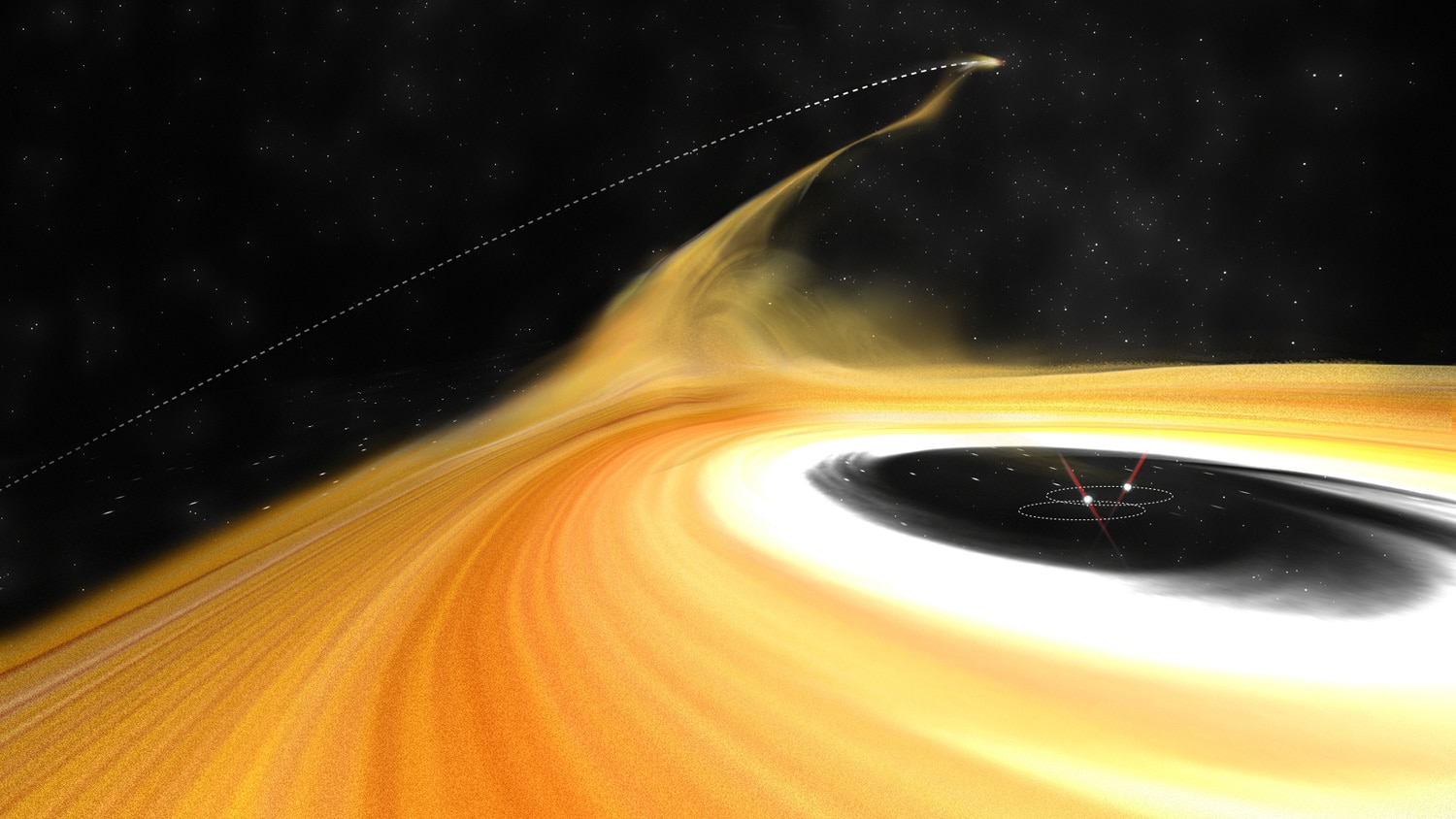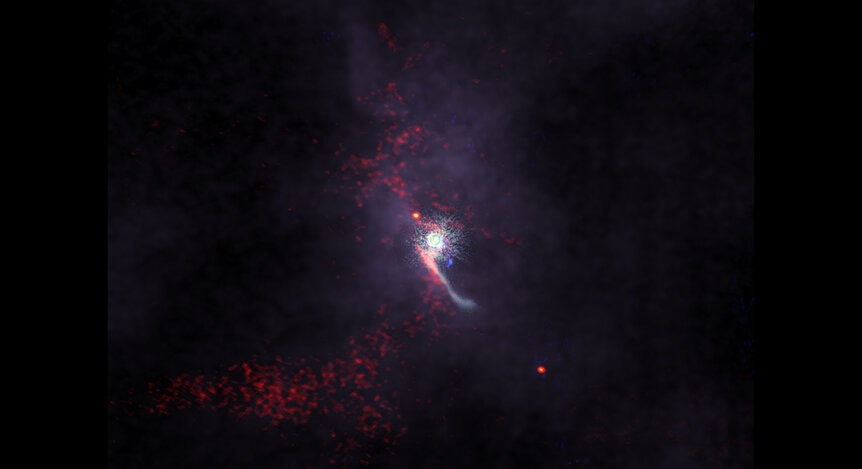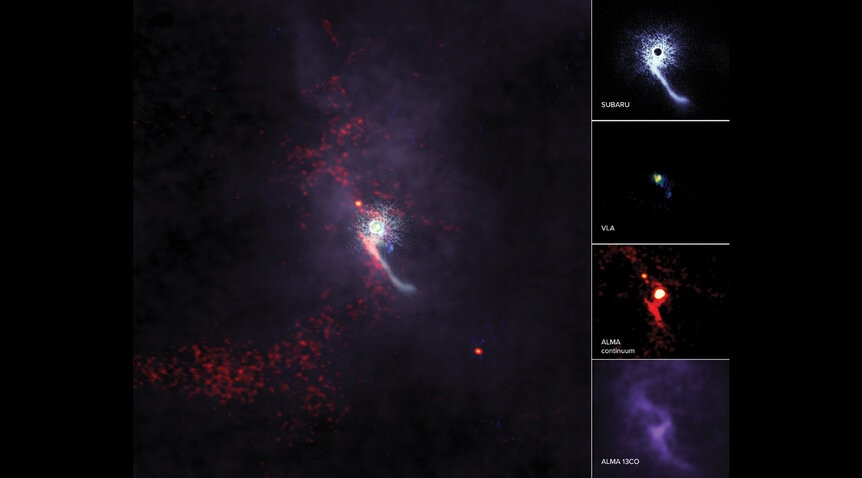Create a free profile to get unlimited access to exclusive videos, sweepstakes, and more!
Stellar intruder makes a grazing hit-and-run on a pair of young stars
Star's flyby disrupts a stellar nursery.

The Sun flies solo through the galaxy, the nearest star to us over 40 trillion kilometers away. But that's not the case for all stars.
Many are in clusters, thousands of stars in close proximity, so close encounters are actually common. But if you rewind the clock, you'll realize those stars formed in that cluster, so there would inevitably be near stellar passes even when some of the stars are still shrouded in the huge disk of gas and dust from which they form. Another star breezing by would gravitationally distort that disk, tugging on it and sculpting patterns in the gas and dust.
A few objects resembling what's expected of a pass like that have been seen, but the evidence was always inconclusive. However, new observations of a relatively nearby object change that game, showing what looks very much like what's expected of a star perturbing a disk. It's not a lock, but it's very compelling.
About 3,700 light years from Earth lies the Canis Major R1 association, an enormous clump of gas and dust actively forming stars in it. There are two clusters of stars forming there, which contain many young stars.
Z Canis Majoris (or just Z CMa) is a member of one of those clusters. It still forming, just a few hundred thousand years old, and is actually a binary, two stars in orbit around one another. One of the stars is about the same mass as the Sun, while the other is a beefy 5 solar masses.
They're separated by well over 10 billion kilometers — more than twice the distance of Neptune from the Sun. They're embedded in an immense disk of gas and dust over 200 billion km across, but each has a much smaller disk surrounding them just a few billion km across. The smaller disks are feeding the stars material so they grow. Sometimes planets form in disks like that as well.
But there's a mystery: A few years ago, observations in infrared showed a wispy streamer coming out of the stars, a narrow finger of dust several hundred billion kilometers long. Its origin was unknown, though a few ideas have been floated, such as it being the wall of a cavity carved out by an explosive outflow event from the young stars, or a spiral arm that formed due to instabilities in the huge disk of dust surrounding the binary. All ran into problems though, so no explanation was entirely satisfactory.
A team of astronomers may now have the solution (link to paper). New observations taken using the Atacama Large Millimeter/submillimeter Array (or ALMA) in Chile and the Very Large Array in New Mexico show more detail close to the binary than ever seen before, and also detect two new objects near the binary.
One, which they call object C (A and B are the two stars in the binary) looks to be another young star that also may have a disk of material around it. It's at least 700 billion km from the binary. Object D is on the opposite side of the binary, closer to it, and likely is a clump of material that's fragmented away from the overall more smooth distribution of material around the stars.
What's so very interesting here is that the long streamer pointing away from the binary points right at Object C.
If Object C really is a star, and is passing by the still-forming binary, then its gravity would warp the disk, and could pull a streamer of material out from behind it as it pulls away. Such an encounter should also create a secondary arm of material that would be pulled out in the opposite direction as well, and these deep images show that too — and it goes right through Object D.
That's very interesting indeed. Simulations using the physics of such an encounter mimic the observations pretty well, adding weight to the idea that we are in fact seeing an intruder star creating havoc in the disk of the binary.
That by itself isn't a slam-dunk, though. But there's more.
Young stars like these sometimes erupt in flares of energy, thought to occur when clumpier material from their disks fall onto them. This generates a lot of energy that blasts outwards, what we call an outburst. Most young stars that do this spend somewhere between 1–10% of their time outbursting.
But both stars of Z CMa are known to outburst, sometimes simultaneously. The odds of this happening are less than 1% by chance, assuming their outbursts are independent. However, if Object C is disturbing the disk then it's expected that the material from farther out will fall onto the stars, creating correlated outbursts from both stars. Since that's what's seen here, this too adds weight to the idea we're seeing a stellar interloper mixing things up.
This story hangs together, but that doesn't mean it's right. What's needed are deeper observations to reveal fainter material so that astronomers can try to untangle the structures around Z CMa and see if that streamer is physically connected to Object C, or if there is some other evidence that the streamer was pulled away from the binary by C's gravity. It would also help to find more objects like this; if we find several more young stars with streamers that point to other nearby stars, then we can be more confident we're seeing a cosmic hit-and-run.
Easier said than done, of course, but lots of new observatories are being built all the time. Perhaps we'll be able to hang a number on how often such events occur, and how that affects the construction of the young stars. We're learning more about how stars and planetary systems form all the time, and to be honest there are still lots of mysteries behind our own solar system's birth and youth. All of these puzzle pieces will, hopefully, allow us to construct a meaningful picture of our own home as it was eons ago.




























